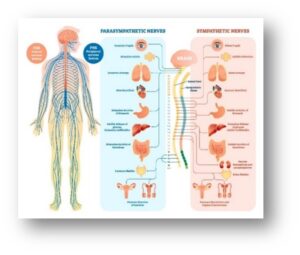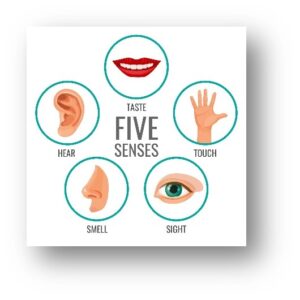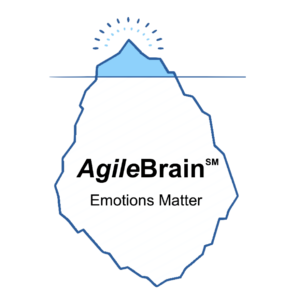

Emotions Are Important
Do you know that emotions, not intellect, primarily drive your decisions? To be truly effective, leaders need to learn about themselves and the emotions that drive them. Go below your surface to discover what’s important to you by taking the AgileBrain assessment to uncover the state of your emotions.
We Have Intelligence Beyond our Rational Minds
For 25 years, I worked for two public policy research organizations in a technocracy that valued cognitive intelligence, research, reasoning, and quantitative analysis. As a result, I interacted with many intelligent, earnest, highly educated, and technically trained people throughout my international career. As a young generalist searching for my place, I admired their skills and expertise and appreciated the focus, vigor, and self-assuredness that they applied to their work. I eventually learned that the thinking world is crowded with many relying on their intelligence, expertise, and laser focus to make their mark in international development. Unfortunately, I also witnessed many specialists floundering when they took on leadership roles, as their expertise often did not translate to a broader set of challenges.
To succeed in my career, I realized I needed to be different. I discovered that my path was to develop my emotional intelligence and attempt to sense, feel, and anticipate things that many colleagues would rarely see. These skills allowed me to successfully lead multi-faceted projects in some of the world’s most chaotic and fragile environments working with diverse groups of people on a broad set of issues.
Why Are Emotions Important?

Neuroscience shows that our emotions impact our decisions more than our thoughts. First, our emotions have greater depth and breadth, with the ability to take in and process information far exceeding the capacity of our rational minds. Second, our emotions are the first thing that kicks in once we face an issue activating our intelligence system well before our cognitive mind. Third, these emotions provide great wisdom that serves our well-being. This inner-knowing draws from our in-born instincts, our nurturing from early childhood, our experiences, the learnings we accumulated in life, and the values and motivations most important to us. Last, our emotions are deeply rooted in protecting ourselves from perceived danger or seeking out positive rewards. Therefore, our emotions sometimes compete with our rational minds and often override our best thinking.
What Is Intelligence?

There are many interpretations of intelligence. I generally regard intelligence as our ability to intake information, hold it as knowledge, and use it in some beneficial way depending on our needs, context, or circumstances. While many believe that our intelligence solely lies within our brain, our whole body makes up a highly integrated intelligence system constantly working for our well-being and survival.
We have three intelligent centers within our bodies: our brain with approximately 100 billion neurons, our abdominal area with 100 million neurons, and our hearts with 40,000 neurons. But, many other parts of our bodies, such as our skin, organs, and connective tissue, comprise our intelligence system too. The flow of information in our bodies is not top-down. 80-90% of our data flows from our bodies to the brain. It’s also important to note that no matter our IQ, the cognitive parts of our brain can process only a fraction of the information exchanged within our bodies.
The Role Emotions Play in Our Intelligence

Our emotions play an essential role in our human intelligence system. While we have much more to learn about our emotions, we know they are deeply embedded in our neurological makeup. Their function is to provide an immediate, instinctual, unconscious, involuntary, and automatic response to an external stimulus that it believes will endanger our survival or provide us with a swift reward. Our emotions not only evaluate and monitor our physical safety but also censor our needs for acceptance and identity and the values and people we hold near and dear to us. Our intelligence system has the potential to process these in our bodies as if our lives depended on them.
In a nutshell, this is how our emotions work. An external stimulus happens outside our bodies and is communicated to us through one or more of our five senses, maybe even six if you consider perception a sense. Our emotions react to the stimulus whether our consciousness is aware of it or not. If warranted, our emotions immediately produce a hormone to inform the body of the catalyst which triggers feelings. We can feel these in our body, such as a knot in our throat (possibly sadness), tingling in our spine (perhaps happiness), or tightness in our belly (maybe fear). We may or may not interpret these feelings in our body by the cognitive areas of our brain.
Interestingly, it only takes a few milliseconds for our emotional system to respond to an external stimulus. In contrast, it can take a full second or more for our cognitive thinking to kick in.
I view emotions as free-flowing energies within our bodies. When we are present with our emotions, they come and go and rarely last more than 90 seconds. Our emotions are neither good nor bad; they are simply the energy that flows through our bodies, providing us with information related to reward and survival. They can manifest themselves as feelings often making decisions without the input or awareness of our cognitive minds. Lingering emotions can become a mood that may last for hours, days, weeks, or much longer. Repressed emotions underlying these feelings can lead to physical, psychological, and relational problems.
Emotional Literacy
 Emotional literacy is our capacity to recognize, understand, and respond to emotions in ourselves and others in constructive, creative, and healthy ways. Since we create language from the thinking areas of the brain, we often find it challenging to attach words to many of the emotions and feelings we experience. Therefore, emotional literacy requires knowledge, awareness, intention, and practice.
Emotional literacy is our capacity to recognize, understand, and respond to emotions in ourselves and others in constructive, creative, and healthy ways. Since we create language from the thinking areas of the brain, we often find it challenging to attach words to many of the emotions and feelings we experience. Therefore, emotional literacy requires knowledge, awareness, intention, and practice.
We have five presenting emotional roots: anger, fear, sadness, happiness, and arousal. We typically experience a wide range of feelings, but any response we emote is some mixture of these five.
These presenting emotions arise from a change in any of our core emotional or motivational needs as humans. In short, there are three levels to our emotional needs: foundational, rising to experiential, and reaching inspirational. These three levels spread over four dimensions of our emotional needs: self, material, social, and spiritual. Therefore, the type and intensity of our presenting emotions is a response, positive or negative, to any of the twelve human emotional needs shown in the table below.
Emotional Needs Table *

* Developed by Leading Indicator Systems for the AgileBrain Assessment
Naturally, the configuration of our emotional needs is unique to each of us and changes and evolves. As we improve our ability to condense and label our emotions to our presenting emotions and emotional needs, we become more skilled in drawing out the wisdom from our emotions. As we allow ourselves to experience each emotion and access its wisdom, we create the foundation for more significant learning, awareness, and consciousness that help us make better decisions for ourselves, our organizations, and the world.
How Can We Grow Our Emotional Awareness?
Acknowledge Them: Emotion is our monitoring and evaluation system that automatically collects our data and gauges where we are at any given period. It is an essential part of our humanity. We cannot be authentic, empathetic, influential, or whole if we deny them.
Honor Them: Research in recent decades has taught us that our emotional powers are often more significant than our intellectual might. Yet, western civilization has influenced us to minimize our emotions, and our educational systems and workplaces have not equipped us to understand and use them properly.
Create Space for Them: We better experience our emotions if we create space in our bodies to access them. We do this by clearing the clutter in our minds and bodies, such as our thoughts, worries, insecurities, and fixations. For this reason, mindfulness activities such as deep breathing, meditation, yoga, or a lunchtime walk in nature can significantly enhance the productive powers of our emotions.
Surrender to Them: Emotion is a life force that we continually experience. Therefore, they should not be denied, controlled, or judged.
Locate Them: We express our emotions through our feelings, which we sense in various areas of our bodies, such as our chest, shoulders, or stomachs, not in our minds. Notice how your feelings affect your body, connect with that area, and be curious about what that feeling is telling you.

Name Them: Emotional literacy begins by identifying and understanding our emotions and attaching language to them. Begin with your five presenting emotions and changes to your twelve emotional needs.
Interpret Them: Every emotion brings wisdom and tries to tell us something. Therefore, once you identify, sense the intensity, and label the emotion, be curious about what that emotion is telling us.
Express Them: Like water moving down a river, we should allow the currents of our emotions to move freely in and out of our bodies without restriction. Our pet cat and dog can do this easily through a meow or bark. Learn to express and release your emotions in balanced and healthy ways and allow them to run their course.
Trust Them: Our emotions bring out an inner knowing far more profound than our conscious mind. In a few milliseconds, they access our instincts, experiences, and learnings accumulated in our lifetime. Our emotions serve and preserve us.
Distrust Them: Be aware that our motions generally have a natural homeostatic bias towards sameness, risk aversion, and safety. However, our emotions require discernment as they do not always tell us the truth. Misunderstood and improperly channeled, our emotions can lead to adverse outcomes such as self-loathing, racism, and violence.
Understand Them: To understand our emotions, we must understand our values, fears, and biases. As we invest in our personal and professional development, we learn about our unique neurological makeups and why we respond to things as we do.
Evolve Them: We don’t need to be held captive by our emotions. Our emotions can change as we learn, grow, and transform ourselves.
Love Them: Our emotions make us unique. To love them is to love ourselves. Properly guided, they can bring out our most powerful, joyful, and loving selves.
Take the First Step to Understand Your Emotions
I’m among a small beta group of coaches currently using a cutting-edge technology called AgileBrain. While traditional assessments gauge the 10% of brain activity in our cognitive minds, AgileBrain is the first instrument to explore the remaining 90% —- the emotions and automatic processes that make up our subconscious and unconscious minds.
 The AgileBrain online assessment accomplishes this by having you rapidly respond to pictures rather than words, which supersedes our thinking minds. Once you complete the three-minute exercise, you will quickly receive your results charting your responses to the full spectrum of our fundamental human needs — four dimensions (self, material, social, and spiritual) at three levels (foundational, experiential, and inspirational).
The AgileBrain online assessment accomplishes this by having you rapidly respond to pictures rather than words, which supersedes our thinking minds. Once you complete the three-minute exercise, you will quickly receive your results charting your responses to the full spectrum of our fundamental human needs — four dimensions (self, material, social, and spiritual) at three levels (foundational, experiential, and inspirational).
The assessment has been developed by leading behavioral scientists using the latest neuroscience research. It has been extensively tested and validated, and peer-reviewed. Learn more about AgileBrain by watching this 90-second video:
Contact Me
Discover more about your emotions, values, and the decisions you make by taking the AgileBrain Assessment. Contact me at dmiller@org-force.com if you would like to take the AgileBrain assessment. Once you complete the exercise, I will provide you with one hour of coaching to help you interpret your results and explore how you can hone your emotional intelligence.
Recent Posts


How to Choose the Right Leadership Coach


